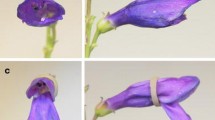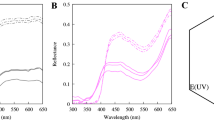Abstract
Most Papilionoideae species exhibit specialized flowers with the standard petal placed in the upper position and the keel and surrounding wings acting as the landing platform for bee visitors. For some groups, however, flowers became resupinate so that bees land at the standard petal. In this upside-down morphology, the pollen is deposited onto the dorsal side of visitors, instead of the ventral side as in most keel flowers. To understand how these inverted keel flowers work and their differences from normal keel flowers, we studied the resupinate species Canavalia brasiliensis, Centrosema pascuorum and Clitoria fairchildiana, and compared with the normal keel Lathyrus pubescens, Crotalaria micans and Dioclea violacea. Both the behavior and morphology of bee visitors were observed and compared to the flower morphology. We observed that most features of the mechanism exhibited by inverted keel flower are found at keel flowers, except for three key innovations: a thickening at wings’ margin in contact with the visitors’ body, tighter interlocking between petals and strengthening of the vexillum structure. Most visitors are adapted to flower characteristics in their morphology and behavior, although some act as thieves due to some of their morphological features, such as mouthpart length. In spite of their differences, bees behave almost in the same way when visiting both normal and inverted keel morphologies. Compared to keel flowers, inverted keel flowers evolved toward more restrictive structures that require large-bodied bees to operate them. Finally, we discuss possible selective pressures that might have led to the evolution of inverted keel flowers.





Similar content being viewed by others
References
Arroyo MTK (1981) Breeding systems and pollination biology in Leguminosae. In: Polhill RM, Raven PH (eds) Advances in legume systematics (part II). Royal Botanic Gardens, Kew, pp 723–769
Cakmak I, Sanderson C, Blocker TD, Phamd LL, Checotahd S, Normand AA, Harader-Patee BK, Reidenbaughf RT, Nenchevg P, Barthelld JF, Wells H (2009) Different solutions by bees to a foraging problem. Anim Behav 77:1273–1280
Cardoso D, de Queiroz LP, Pennington RT, de Lima HC, Fonty E, Wojciechowski MF, Lavin M (2012) Revisiting the phylogeny of papilionoid legumes: new insights from comprehensively sampled early-branching lineages. Amer J Bot 99:1991–2013
Cardoso D, Pennington RT, de Queiroz LP, Boatwrightc JS, Van Wykd BE, Wojciechowskie MF, Lavinf M (2013) Reconstructing the deep-branching relationships of the papilionoid legumes. S African J Bot 89:58–75
Castellanos MC, Wilson P, Thomson JD (2004) “Anti-bee” and “pro-bird” changes during the evolution of hummingbird pollination in Penstemon flowers. J Evol Biol 17:876–885
Chittka L, Thomson JD, Waser NM (1999) Flower constancy, insect psychology, and plant evolution. Naturwissenschaften 86:361–377
Cooley AM, Carvallo G, Willis JH (2008) Is floral diversification associated with pollinator divergence? Flower shape, flower colour and pollinator preference in Chilean Mimulus. Ann Bot (Oxford) 101:641–650
Córdoba AS, Cocucci AA (2011) Flower Power: its association with bee power and floral functional morphology in papilionate legumes. Ann Bot (Oxford) 108:919–931
Etcheverry AV, Westerkamp C, Protomastro JJ (2003) Delayed autonomous self-pollination in the colonizer Crotalaria micans (Fabaceae: Papilionoideae): structural and functional aspects. Pl Syst Evol 239:15–28
Etcheverry AV, Alemán MM, Fleming TF (2008) Flower morphology, pollination biology and mating system of the complex flower of Vigna caracalla (Fabaceae: Papilionoideae). Ann Bot (Oxford) 102:305–316
Faegri K, van der Pijl L (1979) The principles of pollination ecology, 3rd edn. Pergamon Press, Oxford
Franco ALM (1995) Ecologia da polinização e biologia reprodutiva de sete espécies de Phaseoleae (Fabaceae). PhD dissertation. Universidade Estadual de Campinas, Campinas, Brazil
Gómez JM, Abdelaziz M, Lorite J, Muñoz-Pajares AJ, Perfectti F (2010) Changes in pollinator fauna cause spatial variation in pollen limitation. J Ecol 98:1243–1252
Gottsberger G, Silberbauer-Gottsberger I (2006) Life in the Cerrado: a South American tropical seasonal vegetation, vol II. Pollination and Seed Dispersal, Reta
Goulson D (1999) Foraging strategies of insects for gathering nectar and pollen, and implications for plant ecology and evolution. Perspect Pl Ecol Evol Syst 2:185–209
Harder LD (1990) Pollen removal by bumble bees and its implications for pollen dispersal. Ecology 71:1110–1125
Harder LD, Aizen MA (2010) Floral adaptation and diversification under pollen limitation. Philos Trans, Ser B 365:529–543
Herrera CM (2001) Deconstructing a floral phenotype: do pollinators select to corolla integration in Lavandula latifolia. J Evol Biol 14:574–584
Inouye DW (1980) The terminology of floral larceny. Ecology 61:1251–1253
Kajita T, Ohashi H, Tateishi Y, Baileyde CD, Doyle JJ (2001) rbcL and legume phylogeny, with particular reference to Phaseoleae, Millettieae, and allies. Syst Bot 26:515–536
Käss E, Wink M (1996) Molecular evolution of the Leguminosae: phylogeny of the three subfamilies based on rbcL-sequences. Biochem Syst Ecol 24:365–378
Le Roux MM, Van Wyk B-E (2012) The systematic value of flower structure in Crotalaria and related genera of the tribe Crotalarieae (Fabaceae). Flora 207:414–426
Lewis G, Schrire B, Mackinder B, Lock M (eds) (2005) Legumes of the World. Kew Publishing, Kew
Mackinder B, Clark R, Lewis G, Rico L (2014) Legumes of the World online. http://www.kew.org/science-conservation/research-data/resources/legumes-of-the-world
Menzel R (2001) Behavioral and neural mechanisms of learning and memory as determinants of flower. In: Chittka L, Thomson JD (eds) Cognitive ecology of pollination animal behaviour and floral evolution. Cambridge University Press, Cambridge, pp 21–40
Müller A (1996) Convergent evolution of morphological specializations in central European bee and honey wasp species as an adaptation to the uptake of pollen from nototribic flowers (Hymenoptera, Apoidea and Masaridae). Biol J Linn Soc 57:235–252
Schlindwein C, Wittmann D, Martins CF, Hamm A, Alves-Siqueira J, Schiffler D, Machado IC (2005) Pollination of Campanula rapunculus L. (Campanulaceae): How much pollen flows into pollination and into reproduction of oligolectic pollinators? Pl Syst Evol 250:147–156
Stirton CH (1981) Petal sculpturing in papilionoid legumes. In: Polhill RM, Raven PH (eds) Advances in legume systematics (part II). Royal Botanic Garden, Kew, pp 771–788
Sulaiman SF, Culham A, Harborne JB (2003) Molecular phylogeny of Fabaceae based on rbcL sequence data: with special emphasis on the tribe Mimoseae (Mimosoideae). Asia Pacific J Molec Biol Biotechnol 11:9–35
Waser NM (1986) Flower constancy: definition, cause, and measurement. Amer Naturalist 127:593–603
Westerkamp C (1993) The co-operation between the asymmetric flower of Lathyrus latifolius (Fabaceae-Vicieae) and its visitors. Phyton (Buenos Aires) 33:121–137
Westerkamp C (1996) Pollen in bee-flower relationship: some considerations on melittophily. Bot Acta 109:325–332
Westerkamp C (1997) Keel blossoms: bee flowers with adaptations against bees. Flora 192:125–132
Westerkamp C (2004) Flores e abelhas na disputa. Ciência Hoje 34:66–68
Westerkamp C, Claßen-Bockhoff R (2007) Bilabiate flowers: the ultimate response to bees? Ann Bot (Oxford) 100:361–374
Wojciechowski MF (2003) Reconstructing the phylogeny of legumes (Leguminosae): an early 21st century perspective. In: Klitgaard BB, Bruneau A (eds) Advancesin legume systematics part 10. Royal Botanic Gardens, Kew, pp 5–35
Acknowledgments
We thank the Graduate Program in Entomology of the Universidade Federal do Parana for support during development of the present work. Financial support has been received through scholarships from Conselho Nacional de Desenvolvimento Científico e Tecnológico (CNPq).
Author information
Authors and Affiliations
Corresponding author
Additional information
Handling Editor: Louis P. Ronse De Craene.
Rights and permissions
About this article
Cite this article
Amaral-Neto, L.P., Westerkamp, C. & Melo, G.A.R. From keel to inverted keel flowers: functional morphology of “upside down” papilionoid flowers and the behavior of their bee visitors. Plant Syst Evol 301, 2161–2178 (2015). https://doi.org/10.1007/s00606-015-1221-2
Received:
Accepted:
Published:
Issue Date:
DOI: https://doi.org/10.1007/s00606-015-1221-2




